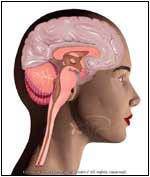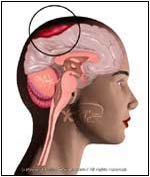|
|
 |
Subacute subdural hematoma
|
 |

Normal |

Abnormal |
| |
- The brain is covered by a membrane (layer of tissue) called the dura. If the veins located below the dura (subdural area) leak blood, then pressure in this area may build up and injure the brain. Head injuries may injure these veins, causing them to be torn and leak. This blood collects into a mass called a hematoma. Hence the name, Subdural Hematoma. For an acute hematoma, symptoms generally occur in the first 24 hours, while for a subacute Hematoma, they occur in the first 2-10 days after a head injury.
|
 |
- Head injury (may be severe or a minor)
- Nausea
- Headache
- Personality changes
- Confusion
- Decreased level of consciousness
- Impaired vision
- Eye droop
- Speech difficulties
- Paralysis
- Numbness or decreased sensation in a limb
- Seizures
- Coma
- Other neurological problems
- Symptoms may initially improve, but then dramatically worsen
|
 |
- Neurological exam by a physician
- Complete blood count, Chemistry panels, a PT, and a PTT should be performed
- CT scan of the head
|
 |
- Very young (infants) or the elderly
- Use of blood thinners such as aspirin or Coumadin
- Alcoholism
- Diseases that increase the risk of falls such as Alzheimer's disease or narcolepsy.
|
 |
- Goal is to reduce pressure on the brain
- Circulation support (intravenous fluids and medications to maintain blood pressure)
- Respiratory support (oxygen and mechanical ventilation if necessary)
- Dexamethasone (a corticosteroid medication) may be used to decrease the inflammation of the brain
- Mannitol (a diuretic) may be used to decrease the swelling of the brain
- Dilantin (a seizure medication) may be used to prevent or control Seizures
- Reversal of blood thinning agents such as Coumadin or Heparin
- Emergency Surgery may be needed to drain the hematoma (blood clot), and relieve the pressure on the brain. The hematoma is outside the brain, but still puts pressure on it. Therefore, the surgery involves drilling small holes in the skull and evacuating the blood. Occasionally, if the hematoma is very large or has solidified, a large opening in skull may be needed (this is called a craniotomy).
|
 |
- The individual needs immediate emergency medical treatment. Untreated, this condition often leads to death.
|
| | |
If you want your friend to read or know about this article, Click here
 |
|
|

